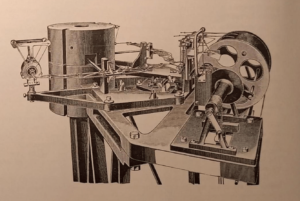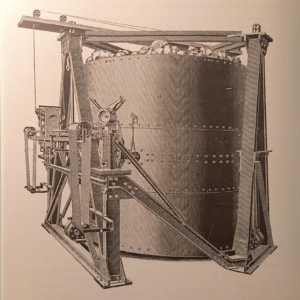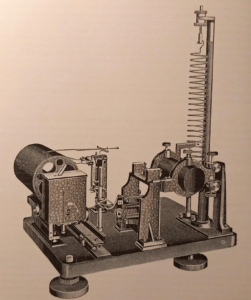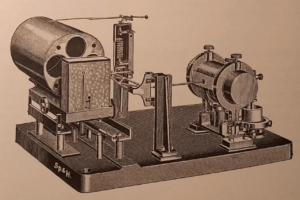Spindler & Hoyer: Catalogue 28

Horizontal and vertical seismographs and vibration recorders
Spindler & Hoyer, Göttingen
Catalogue 28 [transcription]
Astatic horizontal seismograph (No. 178 – 180)

Astatic Horizontal Seismograph (No. 178 – 180)
The seismograph is similar in principle to the often described so-called astatic seismograph of Prof. Dr. Wiechert, only the stationary mass is smaller, namely 80 or 125 or 200 kilos instead of 1000 kilos. The sensitiveness is thereby correspondingly reduced; it has also, as that, an air damper.
The magnification can be regulated from 40 to 160 times, the oscillation period from 4 to 12 seconds, the sensitiveness of inclination from 1 to 15 mm per degree arc. The damping can be cut off and regulated and can be increased up to complete aperiodicity. The friction of the suspension is exceedingly small; at the writing point it can be regulated with care almost down to 1 to 1/2 milligram. The time indication is shown in the curve itself, by the style being moved sideways by magnetic power.
The stationary mass is like an inverted pendulum, the turning point is formed below on the stand by a Cardanic system of springs. The pendulum mass has its centre of gravity 1 meter above the turning point and is at this spot held by the two thrust arms, one in the North-South and the other in the East-West direction. The thrust arms are so long, namely 25 cm, that it is easy to regulate the apperatus to the necessary independence of its components. Each of the thrust arms moves a two-sided lever arm of aluminium, the axle of which is vertical. On one side of the lever arm the air damping is fixed, on the other side a point against which a small thrust arm lies, which moves the writing point. The damping of the air is secured as with the large seismograph, by a piston which moves with small interspace in a cylinder. For the adjustment of the damping the two chambers on the two sides of the cylinder are connected by an adjustable valve. To cut out the damping altogether the two chambers are opened outwards. The damping is so arranged, that only the linear, not the square dimension of the damping, comes into play in equalising the oscillation.

Stationary mass lever system, registration device (No. 178 – 180)
The same writing point is used as with the large seismograph of Prof. Wiechert. It is made very light of aluminium; the point is 15 cm from the axis; an adjustable counterweight enables the pressure of the writing point to be made as small as desired. The first aluminium lever gives a multiplication of about 10 times. As one varies the distance of the point of the thrust arm from the axis in the writing lever, so it is possible to vary the multiplication within the limits named.
The writing pens of both components are writing upon a paper strip, which is normally 90 cm long and 22 cm broad as the strip of the large seismograph. The paper strip is pasted together to form a ring, blackened on the outside, laid upon a cylinder of 20 cm diameter and strained below by an aluminium cylinder, a registration speed of 10 mm per minute is regarded as normal.
The instrument is placed upon the level ground. It is necessary with soft ground to let a pillar of 115 x 115 cm of cement of at least 60 cm thickness into the floor, the upper side of which lies even with the same. It is well if the pillar can be isolated all around by an airspace of 7 cm broad. But even then, with the greatest sensitiveness, the disturbances in the neighbourhood will be noticeable. It is better, therefore, to arange a swinging floor round the apperatus, that is suspended at the greatest possible distance. It is best whent he apperatus can be mounted directly upon rock. It depends on the hardness of the stone if a swinging be thought desirable. If the apperatus stands upon soft ground in a cellar and the pillar is near the walls, walking about in the rooms overhead will be noticeable, even if the disturbances in the indications be not large.
Vertical seismograph (No. 183)

80 kg Vertical Seismograph (No. 183)
The instrument is similar in construction to the large vertical seismograph of Professor Wiechert, but the stationary mass amounts to only 80 kilos. As with the large instrument, it is arranged with air damping and temperature compensation, an adjustable astatic regulator and an adjustable magnification. The magnification can be varied from 40 to 160 times, the oscillation period can be raised up to 6 seconds.
A horizontal lever arm, the vertical axis of which are formed by cross springs, bears the stationary mass on the end opposite to the axis. In the middle the lever is suspended on a powerful spiral spring of 14 mm stout steel wire with a spiral diameter of 20 cm and a tension of 160 kp. The working point is under the centre of gravity for ataining an astatic condition. The spring is suspended above a lever, which rests upon a frame of zinc and iron in a suitable way so that change of temperature is compensated for. One tenth degree of change of temperature would, without the compensation appliance, cause a movement of 3 cm of the writing pen. The entire upper part of the apperatus is enclosed in a case, the double walls of which are filled with insulating material, to protect it against the irregularities of temperature.
The lever of the stationary mass is held by a thrust arm which passes out from a vertical arm of the weight carrier and transfers the motion to the aluminium double lever. This double lever, the arrangement of the writing point, the damping and the registration work are similar in construction to the same parts in the horizontal seismograph. As in that instrument so here all joints consist of springs or points.
The column needed for the erection of the instrument must have a length of 1.50 meter and a breadth of 1 meter and as with the horizontal seismograph must reach to the floor height. As the instrument is not sensitive to side movements, it is not necessary that the column should go down deep, not necessary to insulate the column sideways, not to attach a suspension bed; on the other hand the high sensitivity of the spring to changes in temperature in the room in which it is placed should vary only gradually.
17000 kgs Horizontal Seismograph (No. 167)

17000 kg Horizontal Seismograph (No. 167)
In consideration of the desired enlargement the stationary mass has been increased to 17000 kilos. The mass consists of a cylindrical sheet iron vessel with flat bottom, of not quite 2 meter diameter and not quite 2 meter high, filled with hepatite. The vessel is intended to be free to move horizontally. For this purpose the vessel is suspended by three iron rods of some three centimeters diameter, the elasticity of which allows the necessary freedom of movement; they are attached to three projections at the bottom on the vessel and are carried by an iron frame at the top. The movement of the stationary mass relative to the frame is intended to be indicated by means of thrust arms upon the recording apparatus; to secure this an iron cone is firmly attached by 24 strong iron connections to the bottom and sides of the cylinder filled with hepatite so that it occupies the centre of gravity of the whole. The thrust arm which indicates the one component passes out of the vessel, being protected by an iron tube from the hepatite. The thrust arm moves the indicator point with a total multiplication of 2200 by means of four levers each multiplying 5 times, 5 times, 5 times and 17 1/2 times.
The instrument renders specially important service in the small European earthquakes where the rapid oscillations are more prominent.
The pendulum occupies a space of about 2 1/2 x 2 1/2 meter; the case is 2 1/2 meter high.
1300 kgs Vertical Seismograph (No. 168)

1300 kg Vertical Seismograph (No. 168)
This instrument also registers mechanically; the stationary mass weighs 1300 kilos and the indication is multiplied 160 times; a duration of 7 seconds appears as specially useful at its period; an increase of the force of gravity by 1/200000 part – which corresponds to a variation of one second of arc in the horizontal seismograph – gives as result a deviation of 10 mm. The stationary mass, visible in the figure, is provided by means of a wood and iron box, hanging between the feet filled with hepatite and weighted with iron and lead weights; the box is carried by 8 spiral springs, which are attached, four on each of two opposite edges. For protection against sudden changes of temperature and against further damage in case of any spring giving way, each system of springs is enclosed in an iron case (25 cm x 1 m x 1 m). The built- in springs are supplied by Fried. Krupp, Essen. They are made of 14 mm thick steel wire with rather more than 20 cm curves. Each weighs about 8 kgs, the extension with the weight of about 160 kilos here used, is about 36 cm.
The vertical movement of the hepatite stationary mass is conducted by means of a thrust arm starting from the centre of gravity of the mass upwards, and by means of levers forwards to the writing arm. A simple arrangement (“astatication”) with the use of spring power permits the oscillation to be made as large as desired, but as the elastic influence of the springs entails a limit, so it cannot well exceed 7 seconds (corresponding to an astatication of 30 times).
A change in temperature of one degree Celsius only would in consequence of the change in elasticity of the springs with the sensitivity employed give a deviation of 70 mm; therefore a temperature compensation device is provided, which makes use of the different expansion of iron and zinc. As a result of the excellence of the materials and the excellent temper of the springs no yielding has been observed in the indicating apparatus notwithstanding its sensitiveness.
The comparison of the vertical apparatus records with those of the horizontal seismograph has already resulted in many remarkable consequences; of these this is not the place to speak at length, but it may be remarked that the vertical apparatus offen indicates the first movements of very distant earthquekes better than even the 17000 kilo Pendulum which multiplies 2000 times, thus Schlüter’s result is confirmed that the first movements are of longitudinal kind, having passed the very interior of the globe. The comparison of the records mokes it also certain that the chief movements spread along the earth’s surface.
The pendulum occupies a space of about 1.30 x 1.50 meter: the case is 2 meter high.
Vibration recorder for vertical movements

Vibration recorder for vertical movements (No. 211)
I. Purpose
The Vertical Seismograph type of vibration recorder (No. 211) is designed to register transitory earth tremors in a vertical sense, or the vertical components of such tremors, as are occasioned, for instance, by motorlorries, railway trains, running machinery, blasting operations etc. It thus records, not the velocity or the acceleration of the earth tremors, but their amplitude as a function of time – of course on an enlarged scale. Among the applications of the vibration recorder may be mentioned the investigation of the relations which exist between the vibrations, on the one hand, and on the other the road surface and characteristics, the subsoil, the magnitude and speed of travel of the moving load, the springing of the vehicle, the kind of tyres used, the construction of the buildings, bridges etc.
II. Design and operation
The construction of the vibration recorder is similar to that of Prof. Wiechert’s Vertical Seismograph; it is so designed as to allow of quick and reliable manipulation and of being rapidly transferred from one point to another. The principle is very simple. The earth tremors are transmitted to the rigid framework of the instrument and displace it relatively to an inert mass which on the one side can be rotated about a sprung universal joint and on the other is carried by a vertical spiral spring. The relative vertical movements of the mass are magnified by a lever transmission and converted into horizontal movements of a pencil which records on smoked paper. The movements are damped with paraffin oil. The damping is controllable and is adjusted to a damping ratio of about 6:1 to 4:1. This damping is absolutely essential. If it were not provided, the apparatus would record the amplitude of the earth tremors magnified to different degrees according to the frequency of the exciting oscillation, and such seismograms cannot be evaluated. If, on the contrary, damping is provided, and care is moreover taken that the natural frequency of the apparatus lies sufficiently far below that of the exciting frequency, the earth tremors will be reproduced on the same scale even for different frequencies. The frequency of traffic vibrations lies round about 1/10 to 1/50 second; the natural period of oscillation of the instrument is about 1/2 second, and it therefore fulfils this condition.
The weight of the oscillating mass is 12 kgs, and the magnification can be set to about 30, 60 or 100 times. The recording drum is driven by good clockwork which ensures uniform speed of rotation. By the use of damping air-vanes of different sizes the speed of recording can be varied as required between 20 and 200 cm per minute; it must be fast enough to ensure ample resolution of the curve. The drum moves laterally about 3 mm per revolution.
III. Measurements and evaluation
Before starting on measurements, after setting up the instrument its constants are first defermined. The vibrations which are to be investigated can then be recorded as a seismogram. In evaluation, the earth tremors can be regarded approximately as sinusoidal. The maximum amplitudes of the seismogram and the corresponding wavelengths are measured. The true amplitude A of the earth tremor is obtained by dividing by the magnification factor obtained in determining the instrument constants, whilst a comparison of the wavelengths with the recording speed gives the time period T whose reciprocal is the oscillation frequency n. It is convenient to use the expression A2n3, which is proportional to the energy of the oscillating particles, as a measure for the magnitude of the vibrations.
Vibration recorder for horizontal movements

Vibration recorder for horizontal movements (No. 212)
The horizontal seismograph type of vibration recorder (No. 212), is designed on the principle of the inverted gravity pendulum. In this instrument the inert mass, of the same magnitude as in the vertical seismograph, is arranged above an axis rotation formed by a sprung universal joint. It is free to oscillate about this axis in a horizontal direction and thereby records horizontal earth tremors or their horizontal components in this direction. In other respects the details already given for the vertical seismograph hold good for this apparatus also.



